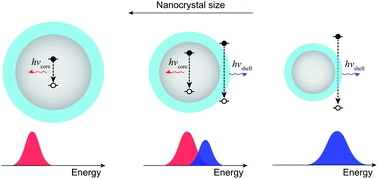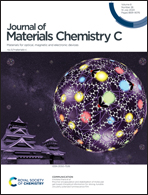Size-dependent critical transition in the origin of light emission from core–shell Si–SiO2 nanoparticles†
Abstract
The origin of the light emission from nanosilicon systems, such as crystalline silicon nanoparticles (Si-NPs), has been an intensively debated issue, with seemingly contradicting literature results pointing to different mechanisms. Here, the origin of the photoluminescence (PL) from application-grade Si–SiO2 core–shell nanoparticles with different sizes and synthesized with the industrially scalable high-yield nonthermal silane plasma method has been elucidated. It is found that the commonly observed PL from these Si-NPs originates, in general, from two processes: recombination within the nanoparticle silicon core and recombination within the oxide shell. The photon energies of both emissions increase with decreasing nanoparticle size. Importantly, a nanoparticle size dependence of the relative contribution of the two processes to the overall PL is established. For large (small) Si-NPs, the luminescence is dominated by the core (oxide-shell) emission. Interestingly, the transition between these two regime limits occurs within an extremely narrow nanoparticle size range (∼0.5 nm). This critical transition, in combination with the close photon energies of the two emission components, is responsible for the common observation of only a single unstructured PL band for Si-NPs and for the seemingly conflicting assignments of the origin of this luminescence found in the literature for apparently similar Si-NPs.



 Please wait while we load your content...
Please wait while we load your content...